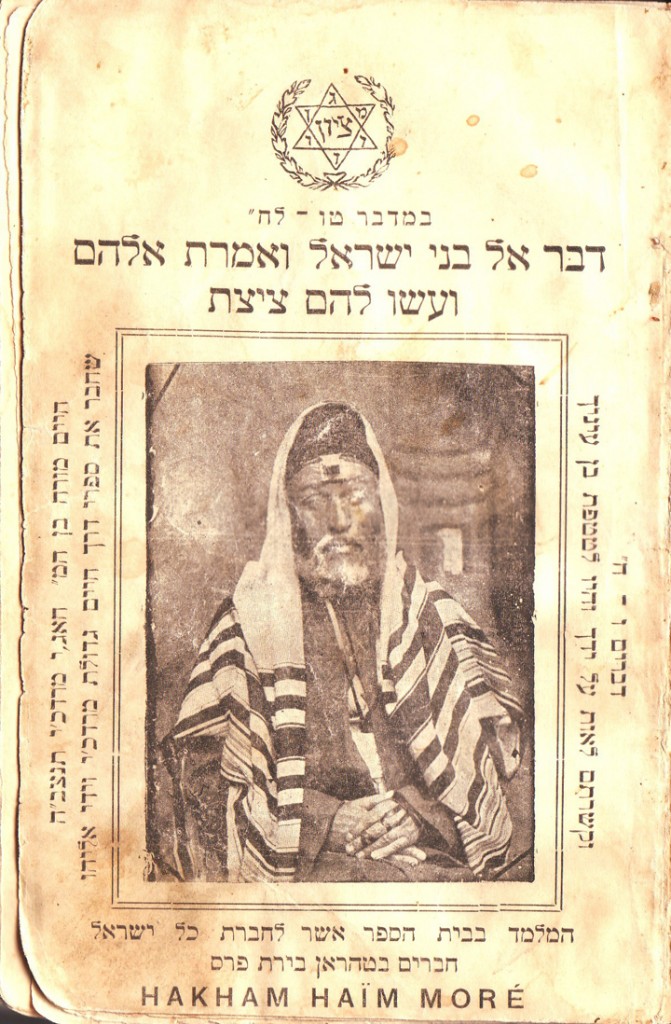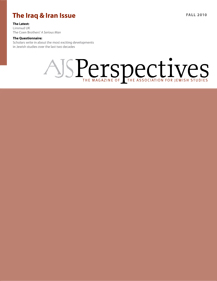
Be this as it may, one may contend that the so-called remoteness of Iran's Jewry poses questions, some of which have broader significance. For instance, if it was indeed segregated, how did such a Jewish community persevere and preserve its Jewish identity? Were Iran's Jews indeed so distant and isolated? Were there relations between Iranian Jewry and other major centers of Jewish life? In other words, the Jewish community in Iran may serve as an important case study of the survival of Jewish life ostensibly distant from centers of Jewish wisdom.
![Manqul al-Ridai [The Sayings Transmitted by Ridai], or Iqamat al-Shuhud fi Radd al-Yahud [Erecting the Evidence in Refuting the Jews] (n.p, 1292/1875–76), an early nineteenth-century Shi‘ite polemic against Judaism, composed by a former Jew, Muhammad Ridai Jadid al-Islam.](http://perspectives.ajsnet.org/wp-content/uploads/tsadik2-700x1024.jpg)
al-Shuhud fi Radd al-Yahud [Erecting the Evidence in Refuting the
Jews] (n.p, 1292/1875–76), an early nineteenth-century Shi‘ite
polemic against Judaism, composed by a former Jew, Muhammad Ridai Jadid al-Islam.
Additionally, rabbis of international renown are not known to have existed in Iran, and religious compositions of Iranian Jews were not studied or quoted outside the Persian world. This may indeed allow for Iranian Jewry's portrayal as detached from the perceived mainstream Jewish world. However, some previously untapped evidence attests to the Jews' knowledge of and commitment to rabbinical Judaism. In this essay, I will demonstrate this knowledge based on some data from the sixteenth century onward. Certain Iranian cities were centers of Torah and learning. Kashan was a major center for religious and intellectual activity in the seventeenth century, as is evident from the fact that several Jewish thinkers and writers hailed from Kashan: the poet Sa'id Sarmad, who converted to Islam, Babai b. Lutf, author of the historical text Kitabi-i Anusi (Book of a Forced Convert), and probably Rabbi Yehudah b. El'azar, author of Hovot Yehudah (Duties of Judah), a book of Jewish thought. Isfahan was another nucleus of Jewish life, as can be seen from the Armenian author, Khwajah Safar, who noted in 1643 that the Jews of Isfahan are "very studious in learning, philosophers . . . perfect in the seven wisdoms. . . . they all—men, women, boys, and girls—know the entire Bible by heart. They are very learned with a proclivity to research. . . .Their craft is reading and learning."
Overall, there were members of the Jewish elite who knew Jewish subjects, such as the Hebrew Bible and its commentaries, Talmud, halakhah, thought, and mysticism. They were engaged with different genres—as the relatively vast number of Judeo-Persian manuscripts testifies—including tafsirs (translations/ commentaries) on the Hebrew Bible, didactic literature, history, and thought. The most significant Jewish composition of Safavid times was Hovot Yehudah (Duties of Judah) by Rabbi Yehudah b. El'azar. The book was written in 1686 in Judeo-Persian and addresses various issues (ma'sheh bereshit and ma'sheh merkavah, the Torah, punishment and reward, messianic days, and resurrection), while espousing a rationalist line. He also writes about mathematics, astronomy, cosmology, medicine, music, logic, and rhetoric, among other issues. Rabbi Yehudah b. El'azar is also comfortable with non-Jewish sources, such as the New Testament, Qur'an, and the writings of Aristotle, Plato, Ibn Sina (Avecinna), al- Shahristani, Ibn Rushd (Averroes), al-Ghazali, Nasir al-Din Tusi, and others. Rabbi Yehudah b. El'azar had no qualms disputing some of his predecessors, including some of the greatest Jewish thinkers. Thus, for instance, in opposition to Maimonides who proposed thirteen principles of Jewish faith, and in contrast to other thinkers who suggested other numbers, Rabbi Yehudah b. El'azar enumerates four principles of Jewish belief.
Iranian Jewry's knowledge is also reflected in incidental letters. A note by David b. Binyamin ha-Cohen of Khunsar in the year TaSaH (c. 1708) testifies to his mastery of different layers of the Hebrew language and its literature. He quotes or paraphrases from the Hebrew Bible, the Babylonian and Jerusalem Talmuds, and the Book of Zohar. Legal questions sent from Iran to highly acclaimed rabbinical authorities abroad—mostly to Baghdad or Jerusalem—testify to the Iranian Jews' familiarity with rabbinical Judaism in the eighteenth to the early twentieth centuries. During the eighteenth century, inquiries were sent from Iran to Rabbi Sedaqah Husin of Baghdad, and in the nineteenth century there are some yet-untapped Iranian questions addressing rabbis in Ottoman Palestine, such as Rabbi Hayim David Hazan (d. 1869), or Rabbi Ya'aqov Shaul Elyashar (d. 1906), as well as Hakham Yosef Hayim (d. 1909) in Baghdad. These questions may indicate their Iranian senders' lack of knowledge and the fact that educated rabbis did not exist in Iran. Nevertheless, the very resort to foreign rabbis indicates that the Jews of Iran valued this type of knowledge; it reflects their desire to follow halakhah as understood outside Iran. Additionally, letters were written by Iranian Jews—indeed a narrow elite of scholars—and dispatched to their foreign coreligionists on various socioeconomic, political, educational, and personal matters. Parts of these letters consist of a very high, multilayered, and sophisticated Hebrew style. Their Hebrew is exceptionally rich, with sentences and expressions drawing on various Jewish traditional sources, such as Hebrew Bible, Talmud, and the mystical literature.
At least some Iranian Jews were exposed to outside Jewish and non-Jewish wisdom. The religious divide between Shi'i Iran and its Sunni adjacent countries did not completely segregate the Jews of Iran, as illustrated by the fact that certain Jewish texts that were published in the Ottoman Empire arrived in Iran. In fact, not only did Jewish books arrive in Iran; but people did as well. Emissaries (SHaDaRI"M) of Jewish-Palestinian communities frequented Iran, seeking pecuniary support. Among other things, these emissaries would advise the indigenous communities on various matters as well as offer legal verdicts. The questions submitted to the foreign emissaries reflect Iranian Jews' knowledge or lack of knowledge in certain Jewish fields (as illustrated by the questions to the emissary Rabbi Yehudah b. 'Amram Diwan in the early eighteenth century), but they always mirror the Jews' adhesion to the pronouncements of these foreign emissary Jews. At times, these emissaries preached to their host communities. Based on the content of the emissaries' sermons, it seems that their Iranian-Jewish audiences were highly knowledgeable and sophisticated in Jewish matters.
Furthermore, Shi'ite texts that attack Jews or Judaism frequently quote from Jewish texts, attempting to demonstrate their fallacy. Some of the major Shi'ite polemicists had Jewish origins, such as Hajj Baba Qazvini Yazdi of the late eighteenth century in Yazd, or the former Jew Muhammad Ridai Jadid al-Islam of early nineteenth-century Tehran. Their anti-Jewish polemics reflect knowledge of Judaism. Retrieving the various sources utilized by these authors furnishes the following tentative list of sources to which they, and by extension their surrounding Jews, had access: the Hebrew Bible, its medieval commentaries, book of Josephun, Nevuat ha-Yeled, medieval Jewish dictionary (Sefer ha-Shorashim), Talmud Bavli, and other texts. At times, some of the books referred to in these Shi'ite texts are known to have existed among the Jews of Iran only through this Shi'ite anti-Jewish usage of them. Even if compared to some other Jewries under Islam, not much of rabbinical/Talmudic literature has survived from Iran, this fact in itself does not necessarily mean that such literature never existed. An illustration of the knowledge of a rabbi in Iran in the late nineteenth and early twentieth century is Hakham Hayim Moreh (d. 1942) of Tehran. Although rather simple in content and style, the works of Hakham Moreh nonetheless exemplify his breadth of knowledge of diverse fields of Jewish wisdom.
The sources of Jewish knowledge in Iran were diverse, and they included local traditions of learning; foreign SHaDaRI"M and itinerant rabbis; Iranian Jews' pilgrimages to Palestine; correspondence with rabbis in Palestine and Iraq; and ordination of rabbis in Iraq. These sources illustrate the Iranian Jews' connection to world Jewry. Still, it is unlikely that the entire community was as well-versed in the above fields as the religious elite, the mullahs/hakhamim/rabbis. Furthermore, it would be difficult to speak of a certain level of knowledge of all of the Jews of Iran as a whole, as there were differences within cities, towns, and villages, as well as from one city to the next. Kashan and Isfahan of the seventeenth century and Yazd of the nineteenth century were centers of Jewish knowledge, whereas in the nineteenth century, Shiraz Jews—as testified by professor E. Z. Melamed—were not truly familiar with the Talmud. In small communities, such as towns and villages, the Jews probably did not know much beyond the bare basics of the Jewish religion.
Finally, the long time span from the sixteenth to the early twentieth century cannot be seen as a bloc. Whereas in the seventeenth century one may speak of highly sophisticated learning in some Iranian locales, by the early twentieth century, the general level of knowledge seemed to have already declined. In the seventeenth century, Rabbi Yehudah b. Ela'zar's impressive Hovot Yehudah addressed the principles of Jewish faith in an innovative and highly sophisticated manner, whereas the early twentieth-century Hakham Moreh's Derekh Hayim addressed the same topic in a popular, easy-to-comprehend, and anythingbut- innovative manner, which reflects the different communities and readers in the seventeenth century and the early twentieth century. From a climax of learning and knowledge in the seventeenth century, Iran's Jews gradually underwent a decline due to various causes: times of heavy persecution and forced conversions, governmental disposal of their writings, poverty, lack of organized communal leadership, and to a limited extent, their living in Shi'ite Iran politically detached from adjacent Sunni countries with their centers of Jewish learning. Nevertheless, even as late as the 1920s, Iran's Jewry cannot be viewed as completely detached from rabbinical and Talmudic writings and world. Indeed, their contact with this world has helped them preserve their Jewish identity in the face of challenges and changing circumstances.

